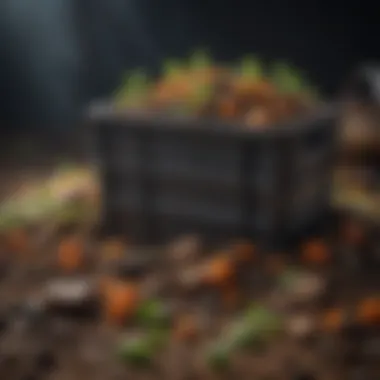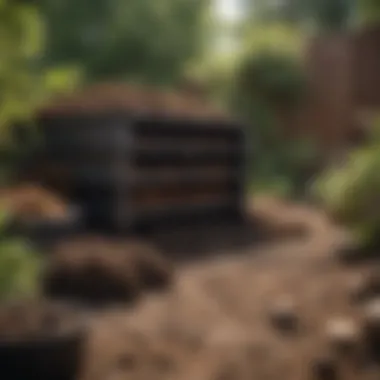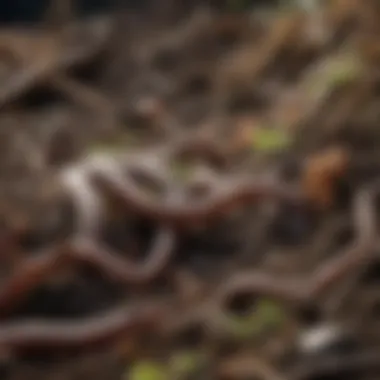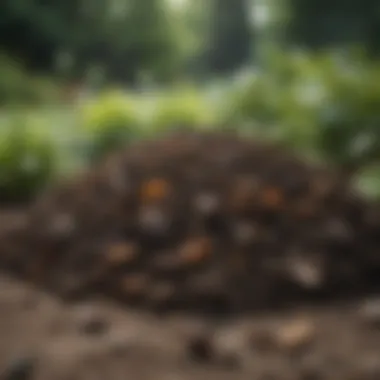A Comprehensive Home Guide to Sustainable Compost Creation


Nature Topic Overview
Composting at home is a sustainable and eco-friendly practice that benefits the environment and your garden. By understanding the basics of composting and leveraging tips to enhance the process, individuals can foster healthier plant growth and reduce waste.
Fun Facts and Trivia
Did you know that composting can divert up to 30% of household waste from landfills? It's not only beneficial for the environment but also easy to do at home with minimal effort. As you embark on your composting journey, visualize how your food scraps and yard waste transform into rich soil enhancer for your plants, making your garden thrive.
Wildlife Explorations
While composting might not involve direct interaction with wildlife, it contributes to biodiversity by enriching the soil and supporting various microorganisms crucial for plant growth. Consider how earthworms play a vital role in breaking down organic matter in your compost pile and aiding in the nutrient cycle. Through small actions like composting, you indirectly support an ecosystem teeming with unseen life forms.
Environmental Awareness
The importance of home composting extends beyond nourishing your garden; it plays a pivotal role in sustainability efforts. By composting your organic waste, you minimize methane emissions in landfills, mitigate greenhouse gases, and reduce the need for chemical fertilizers. Encouraging children to engage in composting fosters a sense of environmental responsibility and empowers them to actively contribute to a healthier planet.
DIY Nature Activities
Get your hands dirty with DIY composting activities that involve children in the process. From creating a mini compost bin using recycled materials to observing decomposition rates of different organic items, there are numerous engaging experiments to educate kids about the natural recycling process. Encourage outdoor explorations to gather materials for composting and witness the transformation from waste to valuable soil additive right in your backyard.


Introduction to Composting
Composting at home plays a vital role in sustainability and environmental consciousness. The process of composting involves converting organic waste into nutrient-rich soil that benefits both the earth and your garden. By understanding the fundamentals of composting, individuals can actively participate in reducing waste while promoting a more sustainable way of living. This section will delve into the core aspects of composting, emphasizing its significance in the broader context of eco-friendly practices.
What is Composting?
Composting is a natural process that decomposes organic materials such as kitchen scraps, yard waste, and paper into a rich soil known as compost. Through the actions of microorganisms, heat, and oxygen, these materials break down over time to form a nutrient-dense substance that enriches soil quality. The resulting compost is a valuable resource for enhancing plant growth, improving soil structure, and fostering a healthy garden ecosystem.
Benefits of Composting
The benefits of composting are multifaceted and impactful. Not only does composting reduce the amount of organic waste that ends up in landfills, but it also helps in nurturing healthier plants and soils. Compost enriches the soil with essential nutrients, promotes the growth of beneficial microorganisms, and aids in retaining moisture, ultimately leading to a more vibrant and sustainable garden. Additionally, composting supports biodiversity by creating a thriving environment for a variety of plant and insect species, contributing to overall ecological balance.
Getting Started with Composting
In this section, we delve into the crucial aspect of getting started with composting, an essential foundation for the entire composting process. Understanding the significance of this initial step is paramount to ensure a successful composting journey. When embarking on the composting adventure, selecting the appropriate compost bin is the first decision you'll need to make. This choice sets the stage for how efficiently and effectively your compost will decompose. Moreover, the size, type, and material of the compost bin play a pivotal role in determining the amount of compost you can produce and the convenience of managing your composting system.
Choosing a Compost Bin
Choosing a compost bin is a pivotal decision that can greatly impact the composting process. There are various types of compost bins available, such as tumblers, traditional bins, and vermicomposting bins. Consider the space you have available, the amount of compost you plan to produce, and your level of involvement in the composting process when selecting a bin. Each type of bin has its advantages and considerations, from compact size for small spaces to high capacity for larger composting needs. Ensure the bin you choose aligns with your composting goals and practical requirements to simplify and streamline your composting routine.
Essential Ingredients for Composting


Composting relies on a balanced combination of organic materials to foster the decomposition process effectively. Essential ingredients for successful composting include green materials rich in nitrogen, such as kitchen scraps and grass clippings, and brown materials abundant in carbon, like dried leaves and wood chips. Achieving the right balance between green and brown materials is vital to ensure a healthy compost pile. Additionally, incorporating water and air into the mix is crucial for promoting microbial activity and breakdown of organic matter. Understanding the role of each ingredient and maintaining the correct ratios is key to generating nutrient-rich compost.
Layering Your Compost Pile
Layering your compost pile is a fundamental technique that enhances the composting process. By alternating layers of green and brown materials, you create a balanced environment for decomposers to thrive. This layering strategy not only accelerates decomposition but also helps prevent unpleasant odors and potential issues like matting. Ensuring proper aeration between the layers and maintaining adequate moisture levels throughout the pile encourages efficient breakdown of organic matter. Strategic layering sets the stage for a well-structured compost pile that matures into valuable compost for enriching your garden soil.
Managing Your Compost
Managing your compost pile is a critical aspect of the composting process as it directly impacts the decomposition and quality of the compost. Regularly turning your compost pile is essential to introduce oxygen, facilitate the breakdown of materials, and prevent unpleasant odors. This aeration process promotes the growth of beneficial microorganisms, accelerating decomposition. By turning your compost pile every few weeks, you ensure a homogenous mixture, creating an optimal environment for microbial activity. Additionally, monitoring the moisture levels and adjusting as needed is vital to prevent the pile from becoming too dry or waterlogged, striking the right balance for efficient composting.
Turning Your Compost Pile
Turning your compost pile helps enhance aeration, enabling the breakdown of organic matter more effectively. This process integrates oxygen into the pile, stimulating microbial activity crucial for decomposition. By regularly turning the compost, you facilitate the even distribution of heat and moisture, aiding in uniform decomposition throughout the pile. Each turn mixes the inner and outer layers, ensuring that all parts receive equal levels of aeration and moisture for efficient composting. Consider using a pitchfork or compost aerator to simplify the turning process, promoting better oxygen diffusion.
Monitoring Moisture Levels
Maintaining proper moisture levels in your compost pile is imperative for successful decomposition. The ideal moisture content ranges between 50-60%, resembling a damp sponge when squeezed. Monitoring moisture levels involves periodically examining the compost pile's feel and appearance. If the pile appears dry, lightly sprinkle water to moisten it. Conversely, if it seems overly wet, incorporate dry materials like shredded newspaper or cardboard to absorb excess moisture. By consistently balancing the moisture levels, you optimize the conditions for microbial activity and decomposition, ensuring the effectiveness of the composting process.
Balancing Green and Brown Materials
Achieving a balanced ratio of green and brown materials is essential for efficient composting. Green materials, like kitchen scraps and grass clippings, provide nitrogen necessary for microbial growth. Brown materials, such as leaves and straw, offer carbon that aids in the breakdown of organic matter. Maintaining a balanced mix ensures proper decomposition and prevents foul odors. Aim for a ratio of roughly 2-3 parts brown materials to 1 part green material. Layering green and brown materials alternately helps create pockets of air within the pile, promoting aerobic decomposition. By maintaining this balance, you foster a healthy compost ecosystem, accelerating the production of nutrient-rich compost for your garden.


Troubleshooting Common Composting Issues
Composting is a rewarding practice, but issues may arise during the process that require attention. Troubleshooting common problems in composting is crucial to maintain a healthy compost pile and ensure optimal decomposition of organic matter. By addressing these challenges promptly, you can enhance the quality of your compost and prevent potential setbacks in your composting journey. This section will explore the significance of troubleshooting common composting issues, offering practical solutions and preventive measures for a smoother composting experience.
Dealing with Odor Problems
Unpleasant odors emanating from your compost pile can be a common issue that discourages many aspiring composters. Understanding the causes of odor problems is essential to effectively tackle this issue. Odors in compost can result from anaerobic conditions, an imbalance of green and brown materials, or the presence of rotting food waste. Implementing proper aeration techniques, such as turning the compost pile regularly, and adjusting the carbon-to-nitrogen ratio can help mitigate odors. By effectively managing odor problems, you can create a pleasant composting environment and continue your eco-friendly gardening practices seamlessly.
Addressing Pest Infestations
Pest infestations in your compost pile can disrupt the composting process and pose challenges to maintaining a healthy ecosystem. Common compost pests include fruit flies, ants, and rodents attracted to food scraps in the pile. To address pest infestations, consider implementing pest-deterring strategies such as burying food waste deeper within the compost, covering the pile with a secure lid, or introducing natural predators like nematodes. By taking proactive measures to deter pests, you can safeguard your compost pile and promote a harmonious composting environment in your home.
Fixing Slow Composting Process
A slow composting process can be frustrating for novice and experienced composters alike, hindering the efficient breakdown of organic materials. Several factors, such as improper aeration, inadequate moisture levels, or an imbalanced mix of materials, can contribute to a sluggish composting process. To accelerate compost decomposition, ensure proper aeration by turning the pile frequently, maintain an optimal moisture balance by watering as needed, and adjust the carbon-to-nitrogen ratio by adding more green or brown materials as necessary. By troubleshooting and rectifying the root causes of a slow composting process, you can rejuvenate the decomposition rate and produce nutrient-rich compost for your garden.
Utilizing Finished Compost
In the final section of our comprehensive guide to making compost at home, we highlight the critical phase of utilizing finished compost. This stage marks the fruition of your composting efforts, where the transformed organic matter is ready to enhance the health and vitality of your garden. Understanding how to effectively utilize finished compost is key to reaping the full benefits of your sustainability practices.
Harvesting and Using Compost
Harvesting compost is a rewarding process that signals the completion of the composting cycle. Once the compost has reached a dark, crumbly texture and a pleasant earthy smell, it is time to gather it for use in your garden. To harvest compost, you can sift it through a mesh screen to remove any large particles that have not fully decomposed. The harvested compost can then be applied to soil as a natural fertilizer, improving soil structure, enhancing nutrient content, and promoting plant growth.
Benefits of Finished Compost in the Garden
The benefits of utilizing finished compost in the garden are manifold. Finished compost enriches the soil with essential nutrients like nitrogen, phosphorus, and potassium, providing a natural and organic alternative to chemical fertilizers. Moreover, the organic matter in compost improves soil structure, promoting better aeration and water retention. By using finished compost, gardeners can enhance soil biodiversity, support beneficial microorganisms, and reduce the need for synthetic additives. Ultimately, incorporating finished compost into the garden ecosystem leads to healthier plants, increased yields, and a more resilient and sustainable gardening practice.







